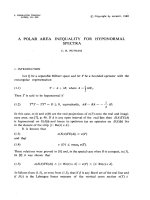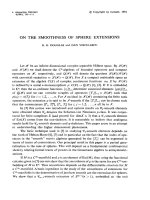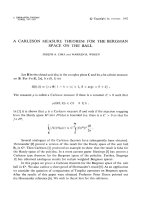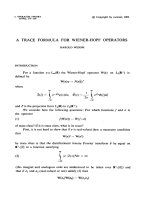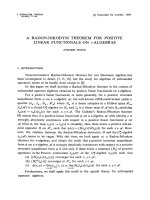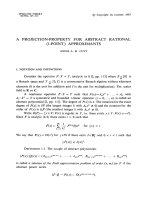Báo cáo toán học: "A LOWER BOUND FOR THE NUMBER OF EDGES IN A GRAPH CONTAINING NO TWO CYCLES OF THE SAME LENGTH" pptx
Bạn đang xem bản rút gọn của tài liệu. Xem và tải ngay bản đầy đủ của tài liệu tại đây (70.94 KB, 6 trang )
A LOWER BOUND FOR THE NUMBER OF
EDGES IN A GRAPH CONTAINING NO TWO
CYCLES OF THE SAME LENGTH
Chunhui Lai
∗
Dept. of Math., Zhangzhou Teachers College,
Zhangzhou, Fujian 363000, P. R. of CHINA.
Submitted: November 3, 2000; Accepted: October 20, 2001.
MR Subject Classifications: 05C38, 05C35
Key words: graph, cycle, number of edges
Abstract
In 1975, P. Erd¨os proposed the problem of determining the maximum number
f (n) of edges in a graph of n vertices in which any two cycles are of different lengths.
In this paper, it is proved that
f (n) ≥ n +32t − 1
for t = 27720r + 169 (r ≥ 1) and n ≥
6911
16
t
2
+
514441
8
t −
3309665
16
. Consequently,
lim inf
n→∞
f(n)−n
√
n
≥
2+
2562
6911
.
1 Introduction
Let f (n) be the maximum number of edges in a graph on n vertices in which no two
cycles have the same length. In 1975, Erd¨os raised the problem of determining f(n)(see
[1], p.247, Problem 11). Shi[2] proved that
f(n) ≥ n +[(
√
8n − 23 + 1)/2]
for n ≥ 3. Lai[3,4,5,6] proved that for n ≥ (1381/9)t
2
+(26/45)t +98/45,t= 360q +7,
f(n) ≥ n +19t − 1,
∗
Project Supported by NSF of Fujian(A96026), Science and Technology Project of Fujian(K20105)
and Fujian Provincial Training Foundation for ”Bai-Quan-Wan Talents Engineering”.
the electronic journal of combinatorics 8 (2001), #N9 1
and for n ≥ e
2m
(2m +3)/4,
f(n) <n− 2+
nln(4n/(2m +3))+2n + log
2
(n +6).
Boros, Caro, F¨uredi and Yuster[7] proved that
f(n) ≤ n +1.98
√
n(1 + o(1)).
Let v(G) denote the number of vertices, and (G) denote the number of edges. In this
paper, we construct a graph G having no two cycles with the same length which leads to
the following result.
Theorem. Let t = 27720r + 169 (r ≥ 1), then
f(n) ≥ n +32t −1
for n ≥
6911
16
t
2
+
514441
8
t −
3309665
16
.
2 Proof of Theorem
Proof. Let t = 27720r + 169,r ≥ 1,n
t
=
6911
16
t
2
+
514441
8
t −
3309665
16
,n≥ n
t
. We shall show
that there exists a graph G on n vertices with n +32t − 1 edges such that all cycles in G
have distinct lengths.
Now we construct the graph G which consists of a number of subgraphs: B
i
,(0≤
i ≤ 21t +
7t+1
8
− 58, 22t − 798 ≤ i ≤ 22t +64, 23t − 734 ≤ i ≤ 23t + 267, 24t − 531 ≤
i ≤ 24t +57, 25t − 741 ≤ i ≤ 25t +58, 26t − 740 ≤ i ≤ 26t +57, 27t − 741 ≤ i ≤
27t +57, 28t −741 ≤ i ≤ 28t +52, 29t −746 ≤ i ≤ 29t +60, 30t −738 ≤ i ≤ 30t +60, and
31t − 738 ≤ i ≤ 31t + 799).
Now we define these B
i
’s. These subgraphs all have a common vertex x, otherwise
their vertex sets are pairwise disjoint.
For
7t+1
8
≤ i ≤ t − 742, let the subgraph B
19t+2i+1
consist of a cycle
C
19t+2i+1
= xx
1
i
x
2
i
x
144t+13i+1463
i
x
and eleven paths sharing a common vertex x, the other end vertices are on the cycle
C
19t+2i+1
:
xx
1
i,1
x
2
i,1
x
(11t−1)/2
i,1
x
(31t−115)/2+i
i
xx
1
i,2
x
2
i,2
x
(13t−1)/2
i,2
x
(51t−103)/2+2i
i
xx
1
i,3
x
2
i,3
x
(13t−1)/2
i,3
x
(71t+315)/2+3i
i
xx
1
i,4
x
2
i,4
x
(15t−1)/2
i,4
x
(91t+313)/2+4i
i
xx
1
i,5
x
2
i,5
x
(15t−1)/2
i,5
x
(111t+313)/2+5i
i
the electronic journal of combinatorics 8 (2001), #N9
2
xx
1
i,6
x
2
i,6
x
(17t−1)/2
i,6
x
(131t+311)/2+6i
i
xx
1
i,7
x
2
i,7
x
(17t−1)/2
i,7
x
(151t+309)/2+7i
i
xx
1
i,8
x
2
i,8
x
(19t−1)/2
i,8
x
(171t+297)/2+8i
i
xx
1
i,9
x
2
i,9
x
(19t−1)/2
i,9
x
(191t+301)/2+9i
i
xx
1
i,10
x
2
i,10
x
(21t−1)/2
i,10
x
(211t+305)/2+10i
i
xx
1
i,11
x
2
i,11
x
(t−571)/2
i,11
x
(251t+2357)/2+11i
i
.
From the construction, we notice that B
19t+2i+1
contains exactly seventy-eight cycles
of lengths:
21t + i − 57, 22t + i +7, 23t + i + 210, 24t + i,
25t + i +1, 26t + i, 27t + i, 28t + i − 5,
29t + i +3, 30t + i +3, 31t + i + 742, 19t +2i +1,
32t +2i −51, 32t +2i + 216, 34t +2i + 209, 34t +2i,
36t +2i, 36t +2i −1, 38t +2i − 6, 38t +2i − 3,
40t +2i +5, 40t +2i + 744, 49t +3i + 1312, 42t +3i + 158,
43t +3i + 215, 44t +3i + 209, 45t +3i − 1, 46t +3i − 1,
47t +3i −7, 48t +3i −4, 49t +3i − 1, 50t +3i + 746,
58t +4i + 1314, 53t +4i + 157, 53t +4i + 215, 55t +4i + 208,
55t +4i −2, 57t +4i −7, 57t +4i − 5, 59t +4i − 2,
59t +4i + 740, 68t +5i + 1316, 63t +5i + 157, 64t +5i + 214,
65t +5i + 207, 66t +5i −8, 67t +5i − 5, 68t +5i − 3,
69t +5i + 739, 77t +6i + 1310, 74t +6i + 156, 74t +6i + 213,
76t +6i + 201, 76t +6i −6, 78t +6i − 3, 78t +6i + 738,
87t +7i + 1309, 84t +7i + 155, 85t +7i + 207, 86t +7i + 203,
87t +7i −4, 88t +7i + 738, 96t +8i + 1308, 95t +8i + 149,
95t +8i + 209, 97t +8i + 205, 97t +8i + 737, 106t +9i + 1308,
105t +9i + 151, 106t +9i + 211, 107t +9i + 946, 115t +10i + 1307,
116t +10i + 153, 116t +10i + 952, 125t +11i + 1516, 126t +11i + 894,
134t +12i + 1522, 144t +13i + 1464.
Similarly, for 58 ≤ i ≤
7t−7
8
, let the subgraph B
21t+i−57
consist of a cycle
xy
1
i
y
2
i
y
126t+11i+893
i
x
and ten paths
xy
1
i,1
y
2
i,1
y
(11t−1)/2
i,1
y
(31t−115)/2+i
i
xy
1
i,2
y
2
i,2
y
(13t−1)/2
i,2
y
(51t−103)/2+2i
i
xy
1
i,3
y
2
i,3
y
(13t−1)/2
i,3
y
(71t+315)/2+3i
i
the electronic journal of combinatorics 8 (2001), #N9
3
xy
1
i,4
y
2
i,4
y
(15t−1)/2
i,4
y
(91t+313)/2+4i
i
xy
1
i,5
y
2
i,5
y
(15t−1)/2
i,5
y
(111t+313)/2+5i
i
xy
1
i,6
y
2
i,6
y
(17t−1)/2
i,6
y
(131t+311)/2+6i
i
xy
1
i,7
y
2
i,7
y
(17t−1)/2
i,7
y
(151t+309)/2+7i
i
xy
1
i,8
y
2
i,8
y
(19t−1)/2
i,8
y
(171t+297)/2+8i
i
xy
1
i,9
y
2
i,9
y
(19t−1)/2
i,9
y
(191t+301)/2+9i
i
xy
1
i,10
y
2
i,10
y
(21t−1)/2
i,10
y
(211t+305)/2+10i
i
.
Based on the construction, B
21t+i−57
contains exactly sixty-six cycles of lengths:
21t + i − 57, 22t + i +7, 23t + i + 210, 24t + i,
25t + i +1, 26t + i, 27t + i, 28t + i − 5,
29t + i +3, 30t + i +3, 31t + i + 742, 32t +2i − 51,
32t +2i + 216, 34t +2i + 209, 34t +2i, 36t +2i,
36t +2i −1, 38t +2i − 6, 38t +2i − 3, 40t +2i +5,
40t +2i + 744, 42t +3i + 158, 43t +3i + 215, 44t +3i + 209,
45t +3i −1, 46t +3i − 1, 47t +3i − 7, 48t +3i − 4,
49t +3i −1, 50t +3i + 746, 53t +4i + 157, 53t +4i + 215,
55t +4i + 208, 55t +4i − 2, 57t +4i − 7, 57t +4i − 5,
59t +4i −2, 59t +4i + 740, 63t +5i + 157, 64t +5i + 214,
65t +5i + 207, 66t +5i − 8, 67t +5i − 5, 68t +5i − 3,
69t +5i + 739, 74t +6i + 156, 74t +6i + 213, 76t +6i + 201,
76t +6i −6, 78t +6i − 3, 78t +6i + 738, 84t +7i + 155,
85t +7i + 207, 86t +7i + 203, 87t +7i − 4, 88t +7i + 738,
95t +8i + 149, 95t +8i + 209, 97t +8i + 205, 97t +8i + 737,
105t +9i + 151, 106t +9i + 211, 107t +9i + 946, 116t +10i + 153,
116t +10i + 952, 126t +11i + 894.
B
0
is a path with an end vertex x and length n − n
t
. Other B
i
is simply a cycle of
length i.
It is easy to see that
v(G)=v(B
0
)+
19t+
7t+1
4
i=1
(v(B
i
) − 1) +
t−742
i=
7t+1
8
(v(B
19t+2i+1
) − 1)
+
t−742
i=
7t+1
8
(v(B
19t+2i+2
) − 1) +
21t
i=21t−1481
(v(B
i
) − 1)
+
7t−7
8
i=58
(v(B
21t+i−57
) − 1) +
22t+64
i=22t−798
(v(B
i
) − 1) +
23t+267
i=23t−734
(v(B
i
) − 1)
+
24t+57
i=24t−531
(v(B
i
) − 1) +
25t+58
i=25t−741
(v(B
i
) − 1) +
26t+57
i=26t−740
(v(B
i
) − 1)
+
27t+57
i=27t−741
(v(B
i
) − 1) +
28t+52
i=28t−741
(v(B
i
) − 1) +
29t+60
i=29t−746
(v(B
i
) − 1)
+
30t+60
i=30t−738
(v(B
i
) − 1) +
31t+799
i=31t−738
(v(B
i
) − 1)
the electronic journal of combinatorics 8 (2001), #N9 4
= n − n
t
+1+
19t+
7t+1
4
i=1
(i − 1) +
t−742
i=
7t+1
8
(144t +13i + 1463
+
11t−1
2
+
13t−1
2
+
13t−1
2
+
15t−1
2
+
15t−1
2
+
17t−1
2
+
17t−1
2
+
19t−1
2
+
19t−1
2
+
21t−1
2
+
t−571
2
)+
t−742
i=
7t+1
8
(19t +2i +1)
+
21t
i=21t−1481
(i − 1) +
7t−7
8
i=58
(126t +11i + 893
+
11t−1
2
+
13t−1
2
+
13t−1
2
+
15t−1
2
+
15t−1
2
+
17t−1
2
+
17t−1
2
+
19t−1
2
+
19t−1
2
+
21t−1
2
)+
22t+64
i=22t−798
(i − 1)
+
23t+267
i=23t−734
(i − 1) +
24t+57
i=24t−531
(i − 1) +
25t+58
i=25t−741
(i − 1)
+
26t+57
i=26t−740
(i − 1) +
27t+57
i=27t−741
(i − 1) +
28t+52
i=28t−741
(i − 1)
+
29t+60
i=29t−746
(i − 1) +
30t+60
i=30t−738
(i − 1) +
31t+799
i=31t−738
(i − 1)
= n − n
t
+
1
16
(−3309665 + 1028882t + 6911t
2
)
= n.
Now we compute the number of edges of G
(G)=(B
0
)+
19t+
7t+1
4
i=1
(B
i
)+
t−742
i=
7t+1
8
(B
19t+2i+1
)
+
t−742
i=
7t+1
8
(B
19t+2i+2
)+
21t
i=21t−1481
(B
i
)
+
7t−7
8
i=58
(B
21t+i−57
)+
22t+64
i=22t−798
(B
i
)+
23t+267
i=23t−734
(B
i
)
+
24t+57
i=24t−531
(B
i
)+
25t+58
i=25t−741
(B
i
)+
26t+57
i=26t−740
(B
i
)
+
27t+57
i=27t−741
(B
i
)+
28t+52
i=28t−741
(B
i
)+
29t+60
i=29t−746
(B
i
)
+
30t+60
i=30t−738
(B
i
)+
31t+799
i=31t−738
(B
i
)
= n − n
t
+
19t+
7t+1
4
i=1
i +
t−742
i=
7t+1
8
(144t +13i + 1464
+
11t+1
2
+
13t+1
2
+
13t+1
2
+
15t+1
2
+
15t+1
2
+
17t+1
2
+
17t+1
2
+
19t+1
2
+
19t+1
2
+
21t+1
2
+
t−571+2
2
)+
t−742
i=
7t+1
8
(19t +2i +2)
+
21t
i=21t−1481
i +
7t−7
8
i=58
(126t +11i + 894
+
11t+1
2
+
13t+1
2
+
13t+1
2
+
15t+1
2
+
15t+1
2
+
17t+1
2
+
17t+1
2
+
19t+1
2
+
19t+1
2
+
21t+1
2
)+
22t+64
i=22t−798
i
+
23t+267
i=23t−734
i +
24t+57
i=24t−531
i +
25t+58
i=25t−741
i
+
26t+57
i=26t−740
i +
27t+57
i=27t−741
i +
28t+52
i=28t−741
i
+
29t+60
i=29t−746
i +
30t+60
i=30t−738
i +
31t+799
i=31t−738
i
= n − n
t
+
1
16
(−3309681 + 1029394t + 6911t
2
)
= n +32t − 1.
Then f(n) ≥ n +32t − 1, for n ≥ n
t
. This completes the proof of the theorem.
From the above theorem, we have
lim inf
n→∞
f(n) − n
√
n
≥
2+
2562
6911
,
which is better than the previous bounds
√
2(see[2]),
2+
487
1381
(see [6]).
Combining this with Boros, Caro, F¨uredi and Yuster’s upper bound, we have
1.98 ≥ lim sup
n→∞
f(n) − n
√
n
≥ lim inf
n→∞
f(n) − n
√
n
≥ 1.5397.
the electronic journal of combinatorics 8 (2001), #N9 5
Acknowledgment
The author thanks Prof. Yair Caro and Raphael Yuster for sending reference [7]. The
author also thanks Prof. Cheng Zhao for his advice.
References
[1] J.A. Bondy and U.S.R. Murty, Graph Theory with Applications (Macmillan, New
York, 1976).
[2] Y. Shi, On maximum cycle-distributed graphs, Discrete Math. 71(1988) 57-71.
[3] Chunhui Lai, On the Erd¨os problem, J. Zhangzhou Teachers College(Natural Science
Edition) 3(1)(1989) 55-59.
[4] Chunhui Lai, Upper bound and lower bound of f(n), J. Zhangzhou Teachers Col-
lege(Natural Science Edition) 4(1)(1990) 29,30-34.
[5] Chunhui Lai, On the size of graphs with all cycle having distinct length, Discrete
Math. 122(1993) 363-364.
[6] Chunhui Lai, The edges in a graph in which no two cycles have the same length, J.
Zhangzhou Teachers College (Natural Science Edlition) 8(4)(1994), 30-34.
[7] E. Boros, Y. Caro, Z. F¨uredi and R. Yuster, Covering non-uniform hypergraphs
(submitted, 2000).
the electronic journal of combinatorics 8 (2001), #N9 6



